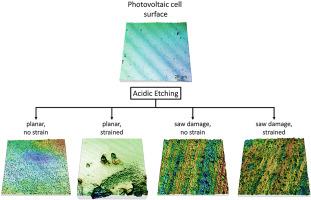当前位置:
X-MOL 学术
›
Mater. Sci. Semicond. Proc.
›
论文详情
Our official English website, www.x-mol.net, welcomes your feedback! (Note: you will need to create a separate account there.)
Lattice strain enhanced acidic etching on as cut sawn silicon wafer
Materials Science in Semiconductor Processing ( IF 4.1 ) Pub Date : 2021-03-01 , DOI: 10.1016/j.mssp.2020.105575 Steven Herold , Jörg Acker
Materials Science in Semiconductor Processing ( IF 4.1 ) Pub Date : 2021-03-01 , DOI: 10.1016/j.mssp.2020.105575 Steven Herold , Jörg Acker

|
Abstract The mechanical processing of silicon wafers leads to a heterogeneous lateral strain distribution and various modifications of the silicon, both of which influence the resulting topography after acid etching. In this study we investigate the influence of local strains and the initial topography of slurry and diamond wire saw wafers on the acid etching mechanism. The strain distribution is quantified and qualified by Raman microscopy before and after thermal treatment, while the topography is characterized by confocal microscopy before and after etching. The thermal treatment was used to selectively relax strains and investigate the effect of the individual strains on the etching mechanism. We found that amorphous silicon and compressive strained silicon are mainly present on the top most surface of the saw damage and do not influence the chemical reactivity of acid etching. In contrast, highly reactive tensile strained silicon is found up to 2.7 μm deep in the saw damage and acts as an etching mask. Rapid etching of the tensile strained silicon by HF/HNO3/H2SiF6 leads to the formation of cracks with high local concentrations of intermediate species. These strains induced cracks are etched out together with the original saw damage induced cracks and trenches and form the final surface after etching. Furthermore, we can show how the tensile strain strength must have a relative Raman shift of at least −2 cm−1 to have an effect on the local etch rate. Our data demonstrate how mechanical treatment in combination with thermal treatment and acidic etching can be used to optimize the resulting topography for applications like photovoltaics. In addition, it provides a deeper insight into the acid etching mechanism for non-planar silicon wafers.
中文翻译:

晶格应变增强酸性蚀刻在切割后的硅片上
摘要 硅片的机械加工会导致硅的横向应变分布不均匀和硅的各种变化,这两者都会影响酸蚀刻后的形貌。在这项研究中,我们研究了局部应变和浆料和金刚石线锯晶片的初始形貌对酸蚀刻机制的影响。应变分布在热处理前后通过拉曼显微镜量化和定性,而形貌在蚀刻前后通过共聚焦显微镜表征。热处理用于选择性地松弛应变并研究单个应变对蚀刻机制的影响。我们发现非晶硅和压缩应变硅主要存在于锯损伤的最上表面,不影响酸蚀刻的化学反应性。相比之下,在锯损伤处发现高达 2.7 μm 的高反应性拉伸应变硅,并用作蚀刻掩模。HF/HNO3/H2SiF6 对拉伸应变硅的快速蚀刻导致裂纹的形成,中间物质的局部浓度很高。这些应变引起的裂纹与原始锯损伤引起的裂纹和沟槽一起被蚀刻掉,并在蚀刻后形成最终表面。此外,我们可以展示拉伸应变强度如何必须具有至少 -2 cm-1 的相对拉曼位移才能对局部蚀刻速率产生影响。我们的数据展示了如何将机械处理与热处理和酸性蚀刻相结合,用于优化光伏等应用的最终形貌。此外,它还可以更深入地了解非平面硅晶片的酸蚀刻机制。
更新日期:2021-03-01
中文翻译:

晶格应变增强酸性蚀刻在切割后的硅片上
摘要 硅片的机械加工会导致硅的横向应变分布不均匀和硅的各种变化,这两者都会影响酸蚀刻后的形貌。在这项研究中,我们研究了局部应变和浆料和金刚石线锯晶片的初始形貌对酸蚀刻机制的影响。应变分布在热处理前后通过拉曼显微镜量化和定性,而形貌在蚀刻前后通过共聚焦显微镜表征。热处理用于选择性地松弛应变并研究单个应变对蚀刻机制的影响。我们发现非晶硅和压缩应变硅主要存在于锯损伤的最上表面,不影响酸蚀刻的化学反应性。相比之下,在锯损伤处发现高达 2.7 μm 的高反应性拉伸应变硅,并用作蚀刻掩模。HF/HNO3/H2SiF6 对拉伸应变硅的快速蚀刻导致裂纹的形成,中间物质的局部浓度很高。这些应变引起的裂纹与原始锯损伤引起的裂纹和沟槽一起被蚀刻掉,并在蚀刻后形成最终表面。此外,我们可以展示拉伸应变强度如何必须具有至少 -2 cm-1 的相对拉曼位移才能对局部蚀刻速率产生影响。我们的数据展示了如何将机械处理与热处理和酸性蚀刻相结合,用于优化光伏等应用的最终形貌。此外,它还可以更深入地了解非平面硅晶片的酸蚀刻机制。



























 京公网安备 11010802027423号
京公网安备 11010802027423号